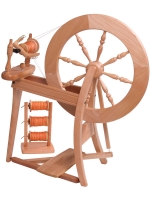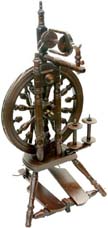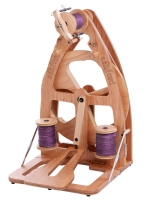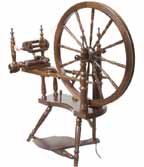Spinning Tips
Selecting a Spinning Wheel
Spinning Wheel Types
Spinning wheels come in different styles. The Saxony, with it's
slanted bed, the upright Castle style, the Norwegian style with it's
double bed and the modern folding or electric spinning wheel. All
spinning wheels used to just have one treadle, but in the last 20
years or so double treadle wheel have won a firm victory among
spinners. Let's take a closer look:
 The Saxony style spinning wheel is what most of us
picture a spinning wheel to look like. It is the fairy tale spinning
wheel most often seen in movies and books. It has a sloping bed that
holds an often large wheel and has three legs. The flyer is offset
to one side (mostly the left, but other variations are available on
some models).
The Saxony style spinning wheel is what most of us
picture a spinning wheel to look like. It is the fairy tale spinning
wheel most often seen in movies and books. It has a sloping bed that
holds an often large wheel and has three legs. The flyer is offset
to one side (mostly the left, but other variations are available on
some models).
Traditionally it used to have one treadle, but it it
now also available from some manufacturers as a double treadle.
Examples for a saxony style wheel are the single treadle
Ashford
Traditional and the double treadle
Kromski Symphony.

Upright Castle style spinning wheel have the flyer centered above the wheel, making them more compact. These spinning wheels range from having a classic look to modern styles that even fold.
Examples for this style of wheel are the traditional looking Kromski Minstrel, the modern minimalistic Ashford Kiwi and the folding ultramodern Schacht Sidekick.
A rarer type of spinning wheel is the Norwegian, with it's typical two beds, that in contrast to the Saxony are not sloped, but straight across. The only manufacturer producing this type of wheel is Kromski with it's stately single treadle Polonaise spinning wheel.
Which spinning wheel is right for me?
When selecting a spinning wheel remember that the wheel has to suit YOUR needs, not anybody else's. The spinning wheel that your friend cherishes may or may not be right for you. Consider the following before purchasing a spinning wheel:
Do you want a portable spinning wheel?

Do you want to take the spinning wheel along to classes, spin-ins etc. If so, portability might be the key and the most important point for you.
Or do you want a large spinning wheel that has lots of momentum and that will not be transported often? Is space a consideration as well? Where will the spinning wheel be stored when not in use?
Does it have to fit in a closet or do you have enough space so that it can grace your living room or den?
Comfort and Availability:
Does the spinning wheel you are about to purchase feel comfortable to YOU when you spin on it? Does it treadle quietly? Is changing bobbins easy? Will you be able to "upgrade" your spinning wheel in the future? For example can you purchase a fast flyer or whorl for high speed spinning for your wheel? Can you get a Jumbo Flyer for spinning Art yarns with your spinning wheel? Will there be replacement parts available should you need them?
Esthetics: What should your spinning wheel look like?
 No, you are not vain wanting a wheel that is absolutely
beautiful to you...you will be the spinner and if looks bother
you from the start, chances are that you might not use your
wheel as often as you had planned.
No, you are not vain wanting a wheel that is absolutely
beautiful to you...you will be the spinner and if looks bother
you from the start, chances are that you might not use your
wheel as often as you had planned.
Spinning on your wheel should not only be a manual process, but also a visual joy.
Kromski Polonaise Spinning WheelSingle Treadle Versus Double Treadle Spinning Wheels
 A lot has been said and written about this topic. A double
treadle wheel
will be a definite plus if you plan to spin for long periods of
time. The double treadles demand that you sit upright in front of
the wheel, (no slouching allowed!), thus giving you better posture
and saving your back. A double treadle spinning wheel also will help a
beginning spinner to "get the wheel going", something that may help
overcome the sometimes frustrating first steps in spinning. So then,
are double treadle spinning wheels better? By all means no! If you
have learned on a single treadle spinning wheel and are comfortable
with it, stick to it. Personal preference is the key here and what
should matter most to you!
A lot has been said and written about this topic. A double
treadle wheel
will be a definite plus if you plan to spin for long periods of
time. The double treadles demand that you sit upright in front of
the wheel, (no slouching allowed!), thus giving you better posture
and saving your back. A double treadle spinning wheel also will help a
beginning spinner to "get the wheel going", something that may help
overcome the sometimes frustrating first steps in spinning. So then,
are double treadle spinning wheels better? By all means no! If you
have learned on a single treadle spinning wheel and are comfortable
with it, stick to it. Personal preference is the key here and what
should matter most to you!
Spinning Fibers
What fiber or wool is best for a beginning spinner?
Most beginning spinners will find a coarser carded wool fiber such as Corriedale Sliver easier to draft and spin.
You can also start with hand dyed Corriedale that is equally easy to draft and comes in many different colors.
Very fine wool fibers such a Merino wool tend to be a little more slippery, so that controlling the twist might be difficult for a beginner.
What is the difference between carded roving and top?
Carded wool slivers are also sometimes called wool roving. They
come in are long band and are ready to spin. During the carding
process wool fibers of different length are blended into sliver
that has lots of loft and air incorporated and is easy to draft.
This fiber preparation will make a springy fluffy yarn when
spun. This fiber is easy to spin for beginning spinners.
Combing wool instead of carding removes the shorter stapled
fibers leaving only the long fibers in a long band that looks
very similar to a carded sliver. The
combed top will make an
even yarn when spun properly and has more resilience to pilling,
since it does not contain short fibers. Combed top, such as a
merino wool top is a premium processed fiber of high quality.
How much fiber will I need for?
Socks: 4 ounces
Vest, medium: 16 ounces
Sweater, medium: 24 to 32 ounces.
Please remember that these are just estimates and that the fiber amount you will need vary greatly from one fiber to another. Design features of your garment such as size, length or knit cables can also add to the amount of fiber you will need to complete your project.
Spinning How-To
Pre-Drafting
Pre-draft your fibers so that they are easier to handle. This is especially true for beginning spinners or for a "thick" roving. Take a strip of roving or combed wool top about one yard in length and split it length wise two or three times. Firmly grip one strip of wool top with two hands held apart about 6 to 10 inches. Gently tug on the fiber until you feel them slip past each other. Move your hands along the length of the fiber and repeat. Remember that you want to "loosen" the wool fiber without tearing the sliver into bits. Careful pre-drafting will result in a more even spun yarn. You may find a how-to spinning book helpful.
Hand Dyed Fibers
Hand dyed wool fibers can be spun in several way to achieve different color results: Spin pre-drafted thin hand painted wool tops and ply at random for the most colorful "barber pole like" effect.
Ply the same wool fiber with itself using the Navaho plying technique for yarns that will change color every few inches.
Sample, sample, sample
Always spin a few yards of sample yarn, ply it, and critically review it. Is it what you had in mind? Is your yarn even and the yarn diameter right for your gauge? Perhaps a knit sample swatch is called for? Take the time to inspect your yarn, and possible revise it. It might save you a lot of time in the long run!
Spinning Accessories
I am a beginning spinner. What do I need besides a spinning wheel and fiber?
Most spinning wheels offer three or four bobbins, which are used for plying your yarns. Three bobbins are the minimum you should have, enabling you to make a two ply yarn. Many spinners keep a lot more bobbins than that on hand so that they can go back and forth from one spinning project to another.
 A
Niddy Niddy is necessary to wind your spun and plied yarn
into a skein.
Doing
so will allow you to count the yards of yarn you have spun, and
will enable you to spin the correct amount for your project. It
is also possible to set the twist of the yarn while it is on a
Niddy Noddy with the help of a hand held steamer.
A
Niddy Niddy is necessary to wind your spun and plied yarn
into a skein.
Doing
so will allow you to count the yards of yarn you have spun, and
will enable you to spin the correct amount for your project. It
is also possible to set the twist of the yarn while it is on a
Niddy Noddy with the help of a hand held steamer.
Don't forget most of all that you will need a "How to spin" book that will come in handy in answering many of your questions.
Ball Winders
Mostly used along with a swift or skein winder, ball winders make center pull balls that are stackable. This makes the yarn a lot more manageable for knitting, crocheting etc. It is also a good way to empty up spinning wheel bobbins for new projects. Once the ball is wound it can be slipped on a Lazy Kate and plied as usual.
Flickers, Hand Carders and Combs
If you raise your own fiber producing animals you will have to process the fiber before it can be spun. You can use
Flickers: The least
expensive of all fiber preparation tools these, Flickers or Flick
Cards are perfect for preparing smaller amounts of fibers. They will
align all the fibers so that they are parallel.
Hand carders: These come in pairs. They
work similar to Flickers, but can hold more fibers. They will align
open your fiber up and incorporate a lot of air into it. This will
allow you to spin a lofty soft and fluffy yarn. Drawback: Carded
fibers still contain most second cuts, noils and some debris, so it
might not wear as well as a combed wool tops.
Drum Carders
Bring out the big guns. For many spinners this is the only way to go. They process fiber quick and operate similar to hand carders. But remember that you have to use a drum carder in order to make it worth your while. Perhaps sharing a drum carder with a spinning fried or guild will bring the cost down for everybody.
Any Questions? Drop us a line and we will try to help!
Bridget
